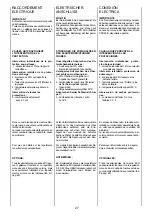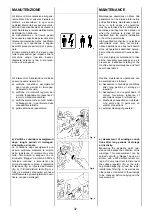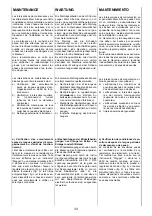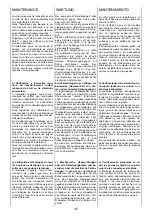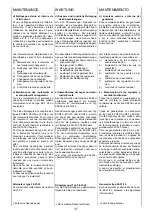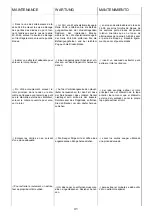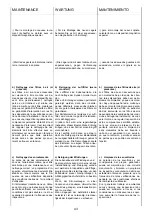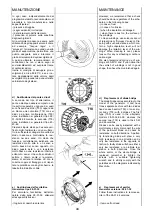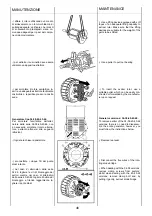
Il valore misurato di resistenza verso
terra di tutti gli avvolgimenti deve essere
superiore a 1M
Ω
.
Nell’ipotesi in cui il valore misurato sia
inferiore a quanto sopra riportato, gli
avvolgimenti devono essere oppor-
tunamente asciugati. Tale operazione
può essere eseguita indirizzando un
getto di aria calda a circa 50-60°C, negli
ingressi o nelle uscite dell’aria del gene-
ratore.
In alternativa a quanto sopra, gli avvol-
gimenti di statore possono essere colle-
gati elettricamente e fatti attraversare
da una corrente mediante un alimenta-
tore in continua; il valore di corrente da
fare circolare negli avvolgimenti dipen-
derà dalle dimensioni dell’alternatore e
comunque dovrà essere stabilito in ac-
cordo ai valori nominali riportati nella
targhetta.
b) Verifiche del corretto funzio-
namento (assenza di rumori o vibra-
zioni anomale).
Ad intervalli regolari raccomandiamo di
verificare che il generatore funzioni re-
golarmente senza rumori o vibrazioni
anomale; tali presenze potrebbero de-
notare il danneggiamento dei cusci-
netti.
Ricordiamo che l’alternatore a sé stante
non presenta vibrazioni particolari in
quanto le parti rotanti sono perfet-
tamente bilanciate. Premesso che la
bilanciatura del rotore non sia stata
alterata e che i cuscinetti dell’alternatore
non siano danneggiati, le cause delle
vibrazioni presenti sul gruppo elettro-
geno saranno da ricercare negli allinea-
menti degli accoppiamenti, nelle solleci-
tazioni del motore termico o nei supporti
antivibranti.
Si raccomanda inoltre di verificare i dati
funzionali che devono risultare in linea
con quanto riportato nella targhetta del
generatore.
c) Verifiche meccaniche su tutti i
bulloni di fissaggio ed in particolare
delle connessioni elettriche.
Ad intervalli regolari raccomandiamo di
verificare che tutti i bulloni di fissaggio
siano adeguatamente stretti; una parti-
colare attenzione deve essere rivolta
alle connessioni elettriche, operazione
che deve essere eseguita con la asso-
luta certezza di assenza di tensione. Nel
manuale del generatore sono indicate le
corrette coppie di serraggio delle varie
dimensioni di bullone.
MANUTENZIONE
34
MAINTENANCE
The figure resulting from the measure-
ment of the windings’ earth resistance
must be over 1M
Ω
.
Should the figure be smaller than the
above-mentioned one, the windings
must be adequately dried up. This can
be done by directing a jet of hot air of
about 50-60°C into the generator’s air
inlets or outlets; alternatively, the sta-
tor’s windings can be electrically con-
nected and a voltage can be passed
through them by means of a direct-
current power supply. The amount of
current in the windings depends on the
generator size, even though it must be
fixed according to the nominal values
stated on the plate.
b) Assessment of current functio-
ning (absence of anomalous noises
or vibrations).
We recommend users to check regu-
larly the correct functioning of the gene-
rator, and to verify that there are no
anomalous noises or vibrations; their
presence might indicate damage of be-
arings.
May we remind you that the alternator
itself has no particular vibration since
the rotating parts are perfectly balan-
ced. Provided that the rotor balancing
has not been altered and that the rotor’s
bearings have not been damaged, vi-
brations in the generator set may occur
due to alignments of couplings, due to
stress upon the combustion engine, or
to vibration mounts.
We also recommend checking of per-
formance data which must comply with
the data on the generator’s plate.
c) Mechanical checks of fastening
bolts and, in particular, of electric
connections.
We recommend a regular check of all
fastening bolts, which must be perfectly
tightened up. Special attention should
be paid to all electric connections; this
inspection must be carried out in the
complete absence of voltage. To
choose the correct tightening wrenches
suitable for the different sizes of the
bolts, see generator manual.








